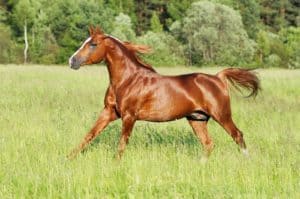Equine Skin Problems and Causes
Skin is a horse’s largest organ, and it’s the only organ that an owner can examine in its entirity and monitor on a daily basis. The skin not only acts as a barrier to outside insults, but protects a horse’s internal structures, allows the
- Topics: Article, Other Skin Problems
Skin is a horse’s largest organ, and it’s the only organ that an owner can examine in its entirity and monitor on a daily basis. The skin not only acts as a barrier to outside insults, but protects a horse’s internal structures, allows the majority of body heat dissipation, and serves as a monitor for general wellness or illnesses. The skin also is subject to attack on a number of fronts, ranging from infectious bacteria or fungus and biting insects on the outside, to liver, nutritional, and other problems on the inside. The results can range from mild (dandruff) to serious (skin cancer).
While there are varied approaches–and many products–available to the horse owner to treat skin afflictions, the best approach is prevention. If, however, your horse does develop a skin problem, it should be addressed immediately. Determining the exact cause of the skin condition and treating it appropriately will ease your horse’s suffering and perhaps result in catching a serious health problem early enough to cure it without loss of competition or riding time. To do this, you should involve your veterinarian. Partner with him/her to ensure that the chosen treatment is effective against the problem your horse is facing. This will keep you from wasting treatment time, and perhaps allowing a minor skin condition to become a major one.
Only Skin Deep
A horse’s skin is its largest body organ, ranging from 12%-24% of the animal’s weight, depending on age. The skin consists of various cellular and tissue components, which are broken down into two major layers: the superficial covering of stratified squamous epithelium called the epidermis, and a deeper layer of dense, irregular connective tissue called the dermis or corium. Scientifically, there are many other “layers” to skin. The dermis in most areas of the horse’s body consists of a superficial, tougher layer called the stratum corneum and a deeper layer that grows called the stratum basle or stratum germinativum. It is in the deepest layers of this portion of the skin that cells divide and begin to push their way into the more superficial layers. These deep layers also are close to the blood vessels, which supply nutrients to the growing cells
Create a free account with TheHorse.com to view this content.
TheHorse.com is home to thousands of free articles about horse health care. In order to access some of our exclusive free content, you must be signed into TheHorse.com.
Start your free account today!
Already have an account?
and continue reading.

Written by:
Les Sellnow
Related Articles
Stay on top of the most recent Horse Health news with












